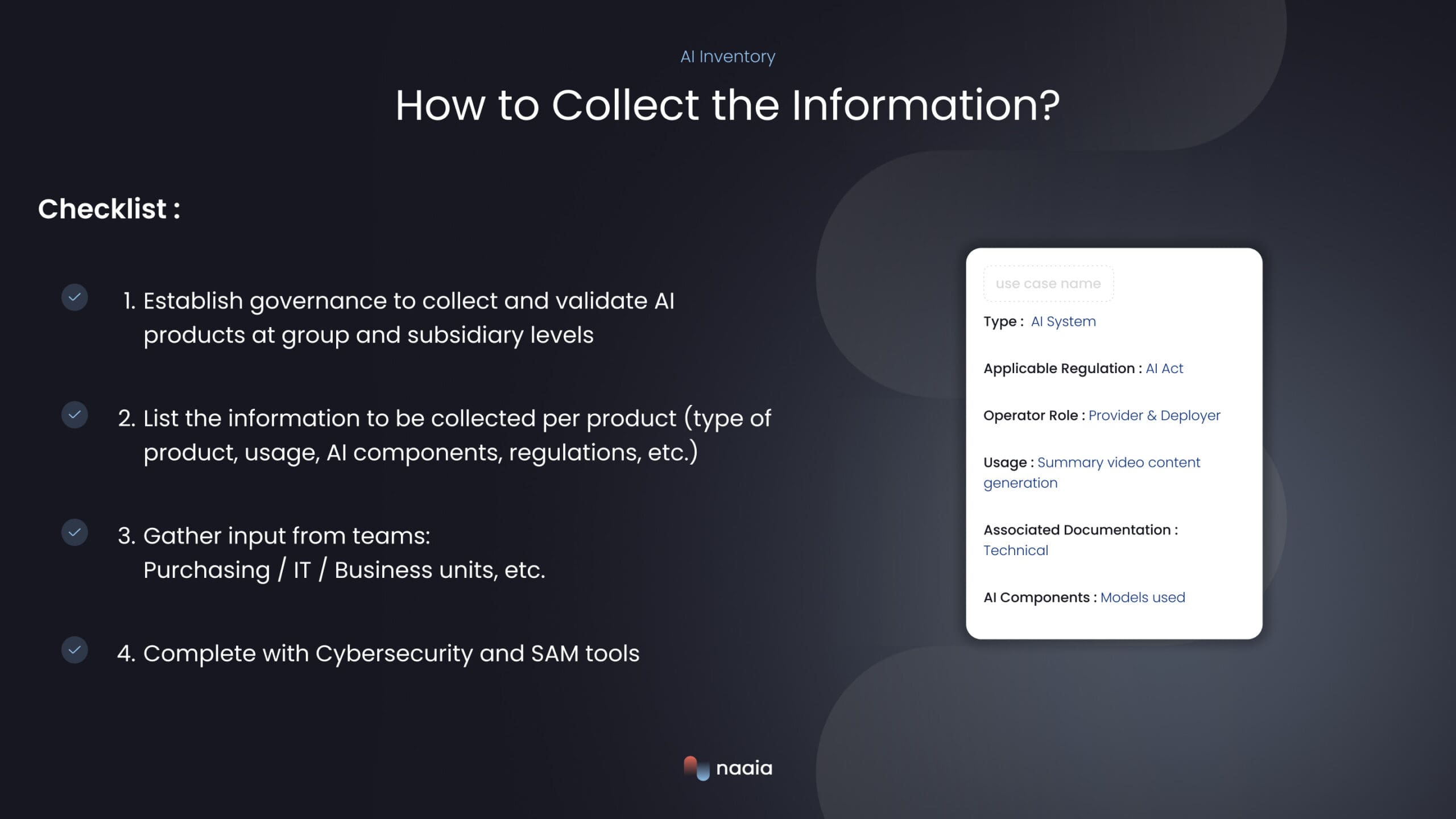Imagine a company deploying dozens of AI projects in parallel: predictive models, intelligent chatbots, recommendation systems…A year later, some projects have evolved, others have remained in the pilot phase, a few have been forgotten.
In the meantime, teams have changed, regulations have intensified, and an external audit is knocking at your door.
Do you know exactly how many AI products you are using? Where are they deployed? Who is responsible for them?
In this growing uncertainty, the absence of a global overview becomes a major risk.
This is where mapping your AI products comes in: an essential step in governing and securing the use of artificial intelligence within your organisation.
Implementing an AI inventory means taking control:
- Identifying all your AI projects across all phases of their lifecycle: under development, in production or under consideration.
- Managing risks, from dependencies to potential failures.
- Ensuring compliance with international regulations (including the AI Act in Europe).
- Optimizing your resources by avoiding redundancies and identifying synergies.
Even better, an AI inventory reinforces your governance maturity and protects your company from the risks of Shadow AI.
Is AI mapping compulsory?
It is not yet explicitly compulsory, but numerous pieces of legislation, such as the European AI Act, impose documentation and transparency requirements that make mapping essential.
And with solutions like Naaia, you can go even further: centralize information, track your product’s evolution and ensure continuous compliance.
In the complex world of AI, knowledge is control.
The importance of AI inventory
An AI inventory makes it possible to identify all the AI projects and solutions whether in development, in production or to come throughout their entire lifecycle.
It offers:
- Global visibility: by avoiding the dispersal of information in silos, it provides a consolidated and accurate view of the entire AI portfolio.
- Proactive risk management: by identifying dependencies, points of vulnerability and potential impacts, the company reduces its operational and ethical risks.
- Increased governance maturity: with clear processes (onboarding, monitoring, updating, archiving), assigned responsibilities and Shadow AI detection.
- Regulatory compliance: by ensuring that each AI product complies with applicable regulations and voluntary standards (AI Act, Chinese laws, US laws, ISO 42001, etc.).
- Resource optimization: by detecting redundancies and synergies to streamline efforts and budgets.
- Cost control: by anticipating applicable regulations from the design phase, to avoid costly readjustments (e.g. development of a prohibited AI system).
What information should be collected in an AI inventory ?
Each AI product or solution should be documented in a consistent manner, with key elements such as:
- Product type: AI system / AI model
- Geographical area: where the organization is based and to which market the AI product is intended to be used
- Operator role: specifying the organization’s role and responsibilities in the AI value chain
- Functional description: use-case details to assess associated risks
- Associated documentation: techniques, internal procedures
- AI components: models used, technological building blocks, providers
- Lifecycle phase of the AI product
How to collect the information?
The collection of information must be organized in partnership with all the stakeholders: data teams, IT, business units, compliance and legal teams, at both group and subsidiary levels.
Success depends on :
- Standardizing the information collected
- Partially automating the data collection when possible
- Regular updating to keep the AI inventory relevant
In a context of fragmented projects and increasing Shadow AI, tools can be used upstream and alongside platforms like Naaia.
Cybersecurity or Software Asset Management solutions can help automatically identify generative AI usage in an automated way, with a centralisation of the tools used. This makes it easier to identify the AI systems that need to be mapped.
Combining these solutions with an AI risk governance and management platform such as Naaia will enable you to inventory your AI systems, but also to document, monitor and manage them within a compliant and collaborative framework.
How can AI mapping be deployed effectively?
Implementing AI inventory requires a structured and reliable tool. That’s where Naaia comes in.
Naaia, your AI management tool
Naaia provides dedicated support to qualify risks and manage AI products throughout their lifecycle:
- Naaia Repository enables you to keep an inventory of your organisation’s AI products.
- Naaia Assess enables advanced qualification of AI products
- Naaia Core generates customised Action Plans by cross-referencing regulatory obligations (e.g. AI Act + ISO 42001)
- Takes into account all AI regulations worldwide, existing market standards and your internal frameworks
- Automatic updates to ensure compliance without administrative overload
- Ready-to-use templates: to quickly generate the necessary documentation
- History and versioning: precise tracking of the development of IA products
Naaia Event Tracker
Additionally, Naaia Event Tracker allows you to :
- Report events and incidents related to AI products
- Manage post-market surveillance to detect risks and trigger corrective measures
A guarantee of security
Naaia is ISO 27001 (information security) and ISO 42001 (AI governance) certified, ensuring optimal data protection and compliance with international standards.
A lever for controlling and anticipating your AI
AI inventory is not a luxury. It’s a necessity if you want to manage effectively your AI projects, ensure compliance, protect your reputation and optimize your resources.
With innovative solutions like Naaia, you can turn a regulatory constraint into a real strategic advantage.
Want to secure your AI projects?
Discover how Naaia can help you set up your AI mapping and strengthen your governance.
